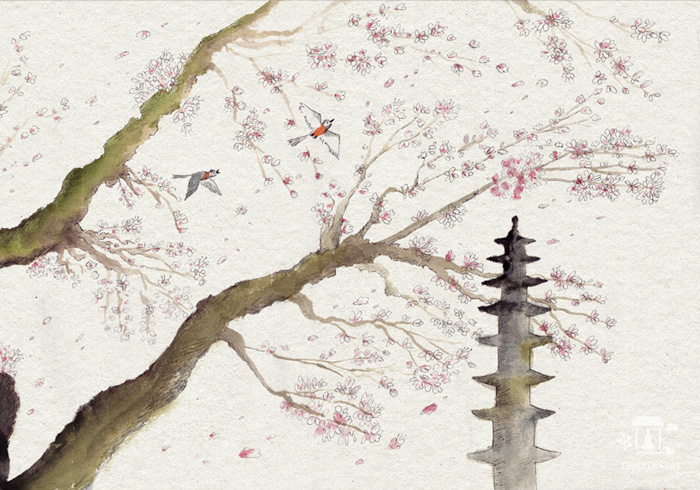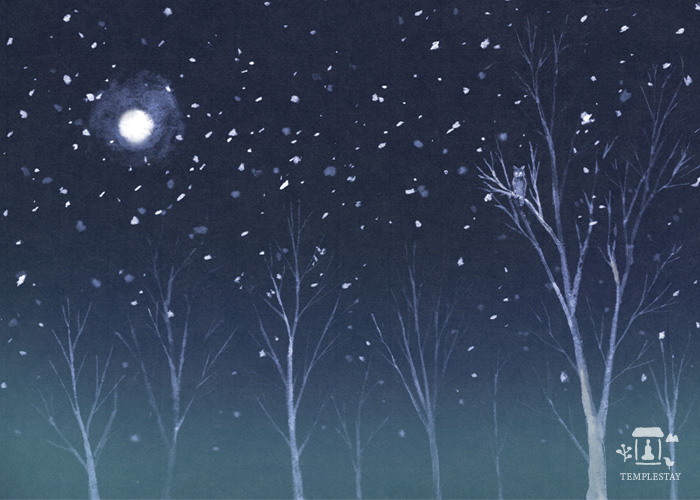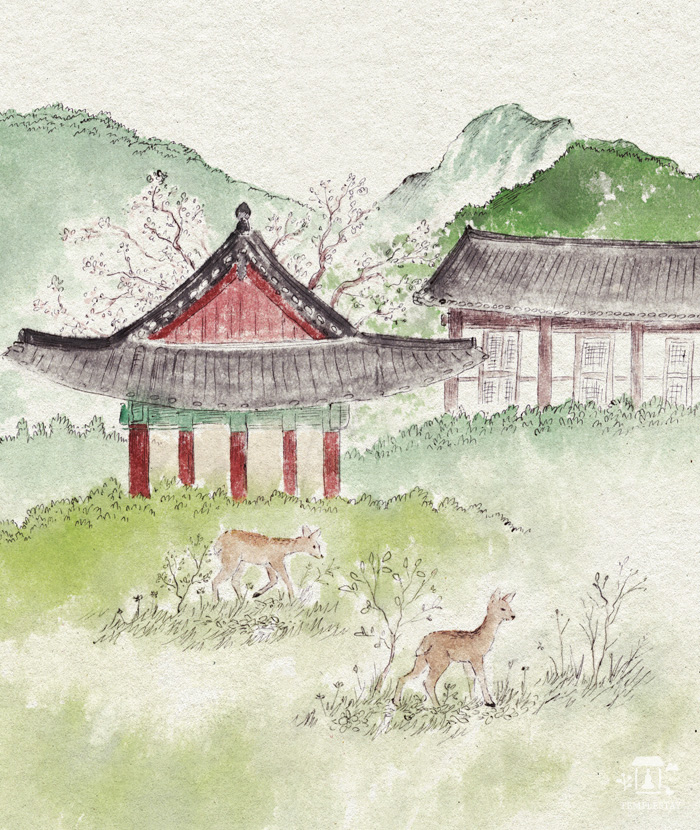Flowers, Stars,
Moon and Mothers
Text by. Lim Taek-su Illustration by. Kim Sang-gyu

Suddenly, spring has come, a time when many things unfold before our eyes, making us gasp in awe. New life is beginning to poke through the surface of our blue planet. It seems like only yesterday that national park trails were closed due to heavy snow.
Spring has come to Baekyangsa Temple too. In its temple compound is a 350-yearold plum tree called “Gobulmae,” which literally means “ancient buddha plum flower.” As a heralder of spring, the red plum blossoms excite photographers every year, and articles about it appear in daily newspapers across the nation delivering news of spring.
A heavy snow fell this past January, covering the mountain slopes and piling up everywhere the orange-flowered surprise lilies faded. It was a time when the Baekdu-daegan Mountain Range—where Baekyangsa Temple is located—paused to catch its breath. A man set up a painter’s easel with a canvas measuring over 160 x 110 cm in front of Gobulmae. For several days I walked around the courtyard and watched him from afar. Then one day, perhaps around the 15th day of the lunar calendar, as I was leaving the main buddha hall after the evening Buddhist ceremony, I suddenly stopped. The artist had disappeared, leaving the painting and easel as if he had forgotten about it.
I admired his painting to my heart's content, filled with a sense of relief that I had not interfered with his work. The picture when viewed under the moonlight was dark and dull, like an old mural. The black bark of Gobulmae exuded a strange energy, and its stems and branches intertwined like a complicated road map. The hardened snow frozen on the branches shone coldly like blades of ice. The tree, exuding only darkness, made me think of a sick animal, a creature ignored by even mountain birds. It was barely surviving the winter, with countless flower petals and scents still trapped inside.
A teacher might ask her students, “What happens when the ice melts?” and many children will respond excitedly “water.” But one child might answer, “Spring comes.” Some people think differently from others. I became curious about the artist who had painted Gobulmae in January—appearing as unattractive as a corpse—rather than Gobulmae blooming red flowers in spring.
I met the artist and served him some warm medicinal herb tea. His beard was well trimmed and precisely symmetrical, like that of Yun Du-seo, a painter and scholar of the Joseon Dynasty. Introducing himself as “a painter of buddha images,” he said he had traveled all over the country for a long time to find buddha images and paint them. In particular, he mainly painted buddhas carved on mountain cliffs, such as those found in Taean and Seosan. He said that once in a while he painted trees, which made him feel he was being somewhat unfaithful. Last year, he painted Baekyangsa Temple’s Korean nutmeg trees (“bija”). On mornings when the humid autumn wind blew through the nutmeg forest, the forest was filled with the scents of tangerine blossoms and herbs. He drew a straight tree trunk with branches spreading out in all directions, and attached to the branches countless times the Chinese character, “非,” meaning “not to be.”
He asked me, “How did you end up coming to this temple?”
He was probably curious about why I came to work at a temple and why it had to be a temple.

In this case, the simplest answer would be “Why not?” but wanting to be polite, I told my story about why I came here. My mother, who was a Catholic from birth, attended a temple in her later years. After fighting some disease for over a year, she passed away. Upon returning to Korea, in her memory I made a pilgrimage to the five major buddha relic temples located all over Korea. That was the beginning of my karmic ties with temples.
He replied, “The answer is usually closer than we realize.”
His voice was kind and his eyes gentle. As he looked over his shoulder, I was reminded of myself wandering here and there, carrying a backpack filled with questions. That was about ten years ago.
He asked, “Have you been to Unmunam Hermitage?”
Then he recommended that I go there, a hermitage managed by Baekyangsa Temple. Telling me it was a place where Seon monks cultivate themselves in Seon practice, he urged me to go. I had already visited Unmunam last fall. People say the hermitage is located where clouds from the northwest and clouds from the southwest pass each other. The scenery there was admired by virtuous masters of ancient times to clear their heads after investigating a hwadu all day long. The view unfolded before me, and a steep ridge suddenly appeared, making me dizzy.
I thought that if I could see that ridge every day, my heart would be sharpened like a knife and my eyes would naturally close. After passing through Yeomhwasil Hall and Unmun Seon Center, I went up to Chilseongjeon Hall via a detour at the end of the road. Once upon a time people looked at the sky and asked the stars for guidance: the North Star, the Big Dipper, Tejaprabhā Buddha, the Seven Primary Star Monarchs, Sunlight Bodhisattva, and Moonlight Bodhisattva. It is said that if you go out into the yard at dawn in winter and look up at the sky, you will see Polaris floating above Unmunam Hermitage.
Darkness is necessary to see the stars clearly.
I stood next to Chilseongjeon Hall at Unmunam Hermitage and looked at the mountain ridges lined up in rows in the distance. Spring flowers would soon begin to bloom on the path below. It reminded me of a Seon poem about a man who went out all day looking for spring, but couldn't find it, but when he returned home, he found that the first signs of fragrant spring were visible on the tips of the plum tree branches.
The painter may have misunderstood me. We live with countless understandings and misunderstandings every day, and sometimes misunderstandings become the driving force of life. His misunderstanding stopped my reminiscing about times long ago when I wandered from place to place.
It seemed like a long litigation was finally over. Some things cannot be undone, and prayers often seem like a weak and pathetic response. I would grow plants, but they kept dying. There were neglected flower pots on my veranda. Someone once told me it was because there was not enough water in my “saju” (a Korean form of fortune telling).

Even though it was evening, my house would be desolate with no lights on, and the days passed without incident. It seemed like sooner or later there would be a permanent sag in my bed in the shape of my body. I spent days lying on my side. The scent of flowers wafted in from somewhere, finally reaching my bed and tickling the tip of my nose as I lay there motionless like a log. I would open my eyes in the dark and get out of the bed after a long while. The scent of flowers wafted out from my narrow veranda. I saw a gardenia tree that had not bloomed for several years. The scent of flowers wrapped around my ankles, crawled over my shoulders, and finally penetrated deep into my lungs. When I looked up, the moon was not visible, and only the night sky was fragmented by passing clouds. Suddenly, I missed my daily life when the moon was my companion. I wanted to live in a house where I could see the moon from anywhere. An unfamiliar desire stirred within me. The moon has been watching over me ever since I was born. A person who reminded me of the moon came to mind, and I recalled a saying: “Only the body is here and the mind is there.”
When reorganizing my house, the biggest headache was books. Even though I had already sent many to used bookstores several times, there were still hundreds left. They were like an enemy attacking and challenging me to fight bravely. Among them were some books that I loved very much. Even if I threw them away, I didn't want to leave any traces of my mind's wanderings for others to see, so I stayed up all night erasing the parts I had underlined.
I felt that the parts I had underlined exposed my inner self and made me vulnerable. When I donated another bunch of books to a used bookstore, a clear sense of self-reproach came over me, as if the act had been underlined with a red pen. I buried my face between the pages of a book and smelled it.
I wanted to hear the author again talk about the present without dwelling on the past.

Winter is the best time to feel the warmth of the sun. No, early spring is better.
If it's too cold, your mind won't be expansive enough to feel the sunlight.
When I'm on a bus going somewhere, there are times when the world outside the window becomes blurry, as if I were looking at it through tracing paper, and I think of the people who have left. At such times, the sunlight on my eyelashes feels like a warm greeting, a greeting from afar sent by those who have left. Maybe they are very close by. I feel the touch of beings who are invisible but speak to me.
The artist loaded his painting on a 1-ton box truck and left the temple. Before he left, he told me that spring at Baekyangsa Temple is as beautiful as the fall.
He said that the light green buds of baby maple leaves and the gray-tinged morning mist combine to create an exquisite atmosphere.
When viewed in broad daylight, his painting was quite different from when seen at night. The tree seemed to wriggle like a black dragon ascending to heaven, and the air surrounding the tree was painted brightly in white mixed with pink. There is no tree in the world that blooms only one flower, but Gobulmae is not concerned with copyright infringement. Finally, Gobulmae—which belongs to all of us—has blossomed.
Kim Sang-gyu studied visual design at Seoul National University.
He is interested in nature, the environment, folk tales, legends, and religion. Starting with his first picture book, Dari's Soul Bead in 2022, he continues to work on picture books. Goryeo Buddhist Paintings, Pictures of Light and Wind , published in 2023, was selected as “an excellent work” in the Sejong Book Liberal Arts category.
Lim Taek-su serves as the Templestay team leader at Baekyangsa Temple in Jangseong. In 2024, he won the Dong-A Ilbo Spring Literary Contest with the short story Long Day, Long Night, and made his literary debut by simultaneously winning the 20th World Literature Award with the full-length novel Kim Seom and Park Hye-ram. He starts every day with a dawn Buddhist ceremony and prayer, and he lives his life forming new relationships every moment at temples.





